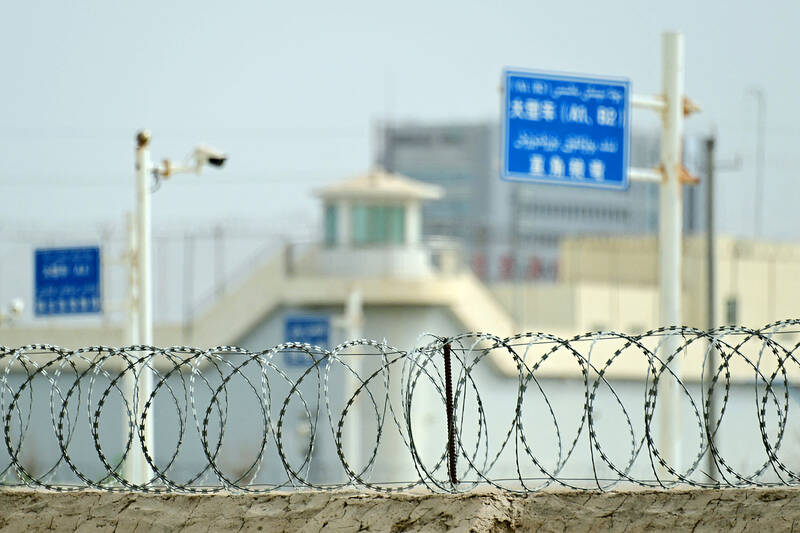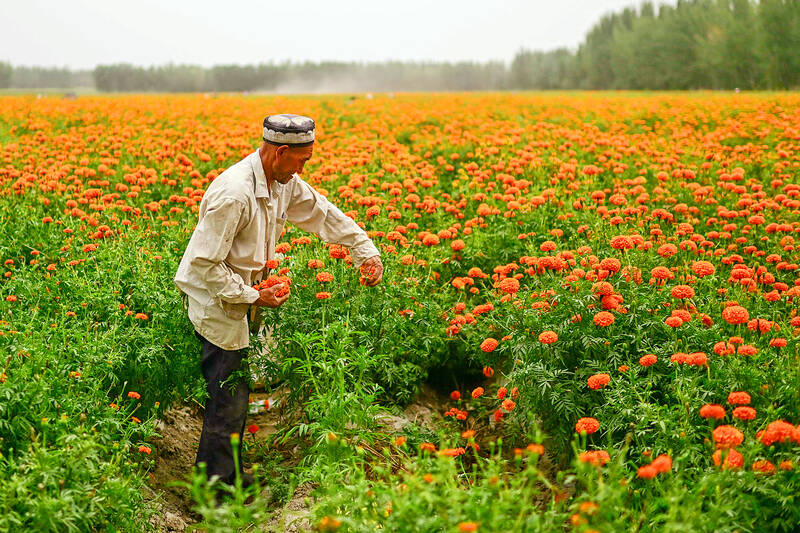Xinjiang is an area that has become associated around the world with detention camps. The facilities are referred to by Beijing as vocational education and training centers. But critics say they are used to indoctrinate Uyghurs and other minority ethnic groups with the goal of transforming them into devotees of the Chinese Communist party.
After unrest in the region and a series of riots and violent attacks by Uyghur separatists between 2014 to 2017, the Chinese leader, Xi Jinping (習近平), launched his Strike Hard Campaign Against Violent Terrorism, leading to the establishment of the camps. The UN has estimated that since then about one million people have been detained in these extrajudicial centers.
People who have spent time in the camps have reported a litany of abuses, including beatings and sexual violence. According to their testimonies, several of the centers also have forced labor facilities in the form of factories.

Photo: AFP
But forced labor in Xinjiang takes many forms, say experts, and is not just confined to the “re-education centers.” Prisoners are co-opted into labor — a feature of the criminal justice system across China. In 2019, a six-year-old girl in south London found a message that was apparently from a prisoner in Shanghai in a box of Tesco Christmas cards. In Xinjiang, the majority of prison labor happens in the agricultural sector, including cotton planting, harvesting and ginning, according to evidence submitted by Laura Murphy and Nyrola Elima, researchers at Sheffield Hallam University, to the UN.
The risk uncovered by the Guardian and Follow the Money in relation to the Bachu biomass facility concerns a third type of forced labor, which is not as widely understood in the west: state-sponsored labor transfers.
Beijing describes these transfers as a poverty alleviation tool and they predate the Strike Hard campaign. The programs work by identifying unemployed people in rural areas and transferring them to farms or factories in different locations where there is a need for workers. This happens within Xinjiang and from Xinjiang to other parts of China.

Photo: AFP
According to research by Murphy and Elima, in impoverished areas at least one person per household is expected to participate in a labor transfer program. The Xinjiang regional government says that about 2.6 million people have been employed through these initiatives. Many of these programs, particularly in southern Xinjiang, are linked to the cotton industry. More than 80 percent of China’s cotton comes from Xinjiang.
In 2020, the Chinese government published a white paper defending many of these policies. Between 2018 and 2019, 155,000 people from poor households and farms “found employment outside of their hometowns and subsequently emerged from poverty,” said the government. The white paper also said that between 2014 and 2019, the average annual disposable income for rural residents increased from 8,724 yuan (US$1,196) to 13,100 yuan (US$1,796).
However, last year, the UN rapporteur on slavery said that “indicators of forced labor” were present in “many” of China’s poverty alleviation programs in Xinjiang.

Photo: EPA-EFE
The labor transfer program has links to the more recent Strike Hard campaign. According to a 2017 government document about how to identify religious extremism in Xinjiang, refusal of government subsidies or assistance is a red flag. Being identified as a potential extremist is grounds to be sent to an internment camp. Uyghurs who have left Xinjiang and academics who study the region say that these programs are not voluntary.
According to a report published by the UN’s human rights chief last year, “the close link between the labor schemes and the counter-‘extremism’ framework, including the VETC [Vocational Education and Training Centre] system, raises concerns in terms of the extent to which such programs can be considered fully voluntary.” The Chinese government said the UN’s report was based on “disinformation and lies fabricated by anti-China forces.”
The Chinese government says the re-education centers were closed in 2019 and most of the students have graduated into stable employment. Journalists who have visited the region have found that many of the facilities appeared to be closed, but there are concerns the detainees have been transferred into the formal prison system rather than being released. In 2018, the number of criminal cases in Xinjiang increased by 25 percent compared with the previous five years; in 2019 the increase was just over 19 percent.

This month the government ordered a one-year block of Xiaohongshu (小紅書) or Rednote, a Chinese social media platform with more than 3 million users in Taiwan. The government pointed to widespread fraud activity on the platform, along with cybersecurity failures. Officials said that they had reached out to the company and asked it to change. However, they received no response. The pro-China parties, the Chinese Nationalist Party (KMT) and Taiwan People’s Party (TPP), immediately swung into action, denouncing the ban as an attack on free speech. This “free speech” claim was then echoed by the People’s Republic of China (PRC),

Exceptions to the rule are sometimes revealing. For a brief few years, there was an emerging ideological split between the Democratic Progressive Party (DPP) and Chinese Nationalist Party (KMT) that appeared to be pushing the DPP in a direction that would be considered more liberal, and the KMT more conservative. In the previous column, “The KMT-DPP’s bureaucrat-led developmental state” (Dec. 11, page 12), we examined how Taiwan’s democratic system developed, and how both the two main parties largely accepted a similar consensus on how Taiwan should be run domestically and did not split along the left-right lines more familiar in

Specialty sandwiches loaded with the contents of an entire charcuterie board, overflowing with sauces, creams and all manner of creative add-ons, is perhaps one of the biggest global food trends of this year. From London to New York, lines form down the block for mortadella, burrata, pistachio and more stuffed between slices of fresh sourdough, rye or focaccia. To try the trend in Taipei, Munchies Mafia is for sure the spot — could this be the best sandwich in town? Carlos from Spain and Sergio from Mexico opened this spot just seven months ago. The two met working in the

Many people in Taiwan first learned about universal basic income (UBI) — the idea that the government should provide regular, no-strings-attached payments to each citizen — in 2019. While seeking the Democratic nomination for the 2020 US presidential election, Andrew Yang, a politician of Taiwanese descent, said that, if elected, he’d institute a UBI of US$1,000 per month to “get the economic boot off of people’s throats, allowing them to lift their heads up, breathe, and get excited for the future.” His campaign petered out, but the concept of UBI hasn’t gone away. Throughout the industrialized world, there are fears that